If you asked me to visualize in my mind a “book for children” – if you gave me a description that vague, asked me to roll with it, and said “just picture a kids’ book in your head” – chances are, the first thing I’d think of would be a Tomie dePaola illustration. Even if you’re not familiar with the name (and most of you probably are), almost everyone in the Western world and beyond probably has had some experience with a Tomie dePaola book. According to his website, he “has written and/or illustrated nearly 250 books”, which doesn’t surprise me. His visual style and storytelling skill are just so beautiful, iconic, and ubiquitous that Tomie books are almost a genre unto themselves. I think it’d be fairly hard to find a child’s home library that doesn’t have at least one dePaola title prominently featured in its collection.
It also doesn’t hurt that many of his books are card-carrying kids’ classics. When my daughter first started asking us about death at age three, we immediately turned to my wife’s dog-eared childhood copy of Nana Upstairs & Nana Downstairs – if you have elderly relatives, readers, you need to have that book on standby – and Strega Nona, possibly dePaola’s most famous work, is a home library essential and one of the most memorable books from my own childhood. (A local children’s theater company, The Wild Swan Theater, does a tremendous stage adaptation of Strega Nona that my daughter adores.) However, even though Nana Upstairs and Strega Nona are both must-own works and probably dePaola’s best known titles, my daughter and I have always had a special place in our hearts for The Knight and the Dragon, a rousing tale of dragon fighting, rejecting social roles, and the wonderful things that can happen when you take the advice of a librarian.
Once, when my daughter was two and half, I took her to our local bookstore and told her that she could pick out whatever book she wanted. She headed off into the stacks and, though I’d mentally prepared myself for coming home with an Elmo book, instead, she eventually emerged holding a paperback copy of The Knight and the Dragon. “I really want this, Daddy,” she said.
Though I was familiar with Tomie dePaola, I’d never read The Knight and the Dragon, so we sat down in the store and we read it together. Minutes later, we reached the end of the story and we both just sat there with goofy, delighted smiles on our faces. “We need this book, Dad,” she told me and, while I totally admit that she might have been manipulating me into buying her something… well, it worked. Despite my best efforts, I am a very manipulatable daddy, particularly when it comes to buying books. We bought it and it’s become a big favorite in our house.
What I like the most about The Knight and the Dragon is how it plays with the expectations that readers have for certain kinds of stories. Before we read the book, I asked my daughter, “What do you know about knights and dragons?” And she replied, “That they fight.” I’m not even sure how she knew that. At the time, I’m pretty sure we didn’t have any books with dragon-slaying on her shelves and I’m not sure where – in her limited TV and movie watching – any knightly combat could’ve come up. Maybe it’s just one of those cultural landmarks that people just KNOW about. I knew that Rosebud was a sled long before I ever saw an Orson Welles movie, so maybe, kids just know deep down in their collective unconscious that knights and dragons don’t get along.
And the opening of The Knight and the Dragon plays with that implied cultural knowledge. The book opens with the lines:
Once upon a time, there was a knight in a castle who had never fought a dragon.
And in a cave not too far away was a dragon who had never fought a knight.
The first page that accompanies those lines shows the knight and the dragon both staring at the reader with surprised, slightly embarrassed looks on their faces, as if they’re saying, “yeah, it’s weird that we’ve never fought each other, isn’t it?” In the following two pages, the knight goes to the library and the dragon finds his own books and they both start reading about how to fight each other. Once they’ve confirmed their cultural suspicions – that the expectation is that they’re SUPPOSED to fight – the knight and dragon both start preparing themselves for their presumed battle.
First, they start with books. The knight reads a book on “Armor Building” and the dragon studies a volume on “The Art of Tail Swishing.” Next, they gather their necessary tools. The knight assembles an armory of weapons – when my daughter was two, this part used to upset her (she loves it now) – while the dragon rehearses his scary faces in a mirror. And, finally, they practice their combat skills. The knight attacks a wooden practice dragon and the dragon charges a straw-filled knight. At first, they can’t even hit their targets, but, with practice, they get better and better. With their skills seemingly perfected, the knight and dragon send each other very polite invitations to battle and they set the time for… the fight.
While the story is gentle enough that you know that neither of the combatants is going to end up getting hurt, what I like about The Knight and the Dragon is how sympathetic that dePaola makes the two lead characters. They’re both very likeable and innocent and, although you feel a certain amount of pride building as their combat skills improve, you can’t really imagine them actually going through with the fight. They’re like kids on the playground who have been manipulated into a fight that neither of them wants to go through with, BUT, since there is this huge cultural expectation that knights and dragons FIGHT, both of the characters are so earnest and good-natured they just seem to feel that they HAVE to go through with it.
So, the fight commences and… it’s a mess. After their first charge, the knight ends up in a tree, the dragon ends up sprawled in a pond, and neither of them looks particularly happy. At this point, a lovely librarian, who’s been lurking in the background while the two leads both diligently researched their expected behaviors, arrives in her horse-drawn bookmobile and hands them each a book. The dragon gets “The Outdoor Cook Book” and the knight gets “How to Build a Bar-B-Q.” The studious duo sits down to read and, in the final spread, we see the results of their new research. Rather than fighting, which obviously makes neither of them happy, the knight and dragon decide to use their inherent skills – the dragon’s fire-breathing and the knight’s skill with metal-working – to do something more productive: they open a barbeque restaurant together.
It’s a cute ending, especially since no one wanted to see the good-natured knight and dragon hurt each other anyway, but it actually has this quietly powerful message about conflict resolution hiding beneath its surface. The knight and dragon start the story being embarrassed that – as knights and dragons – they haven’t fought each other. They have no reason to fight aside from that deep-seeded cultural expectation that they will. They spend a considerable amount of time using their natural talents to prepare for this assumed conflict and, after the conflict goes wrong and they both realize that the fighting isn’t making them happy, they find a way to use their talents to break the cycle and find a new path that gives them both a lot more satisfaction and peace. It’s a beautiful moment.
And, in terms of storytelling expectations, it was fun to see my daughter watching these characters moving toward this inevitable conflict and then have the conflict turned on its ear. Her expectation was that the knight and dragon would fight, but she found them both so cute that it was obvious that she didn’t want to see one of them standing over the broken, defeated body of the other one. But, deep in her brain, she EXPECTED that conflict to occur. So, when a librarian shows up, defuses the situation, and convinces them that it’d be much more fun to open a restaurant, she didn’t quite know how to process it at first. She didn’t know that “they might chose not to fight” was an option, but, once she realized that it was, she was DELIGHTED. “So, dragons and knights can be friends?” she asked me. I said something about “well, sometimes, they can” and she couldn’t have been happier with that answer.
“I’m glad they tried to fight,” she told me. “But only because it was funny.” And I was then asked to explain the concept of barbequed pulled pork sandwiches to her. (She’s not a fan.)
I love having The Knight and the Dragon in our home library because I love books that both address and defy storytelling conventions. On one hand, it feels right that my daughter’s home library has a book about knights and dragons fighting. It’s just one of those cultural storytelling archetypes that it feels like every kid just needs to be exposed to at some time. (I wrote a blog post about a similar topic called “The Difficult Task of Introducing Your Kid to Folk Tales and Fairy Tales.”) On the other hand, I’m glad that our first book about that big cultural elephant in the room – that knights and dragons are expected to fight – also includes the message that the outcome isn’t always written in stone and, just because society expects a story to go one certain way, that doesn’t mean that’s necessarily how that story has to play out.
And I give Tomie dePaola all the credit in the world for continuing to create children’s books that exemplify the best in classic storytelling, but with his own slant on the material that, in my eyes, makes even the oldest stories feel fresh and relevant.
THE DETAILS ON THE KNIGHT AND THE DRAGON:
AGE RANGE: The stated age range is 4 and up, but the illustrations are so big and evocative and the story is so relatively gentle that I wouldn’t worry about reading this to much younger readers. Like I said, my daughter was two when she discovered The Knight and the Dragon and she loved it. The first time we read it, she had a momentary bit of nervousness when the knight prepared his weapons for battle. (“He isn’t going to stab the dragon, is he?”) But that quickly passed.
PAGE COUNT: 32 pages
RELATED WEB SITES: Tomie dePaola has a very cool website, with information on the author, his books, his artwork, his thoughts on being an artist, etc. It’s a great resource.
BUY IT, BORROW IT, OR FORGET IT?: While The Knight and the Dragon isn’t as essential a title as either Nana Upstairs & Nana Downstairs or Strega Nona, I still have a whole lot of affection for this book. It’s fun, sweet, and surprisingly deep and it has a librarian save the day. I’d say buy it if you can.
IF YOU LIKED THE KNIGHT AND THE DRAGON, YOU MIGHT ALSO LIKE:
- The Three Pigs by David Wiesner – The Three Pigs is another picture book where the characters in a story defy what you expect them to do. As the titular pigs move towards their confrontation with the wolf, they suddenly decide to jump into the page margins of their book and explore the options of some of the other storytelling universes around them. The pigs eventually find a dragon who chooses to accompany the pigs back to their story – rather than sit around and wait for a knight to slay him – and moves into their brick house, much to the shocked dismay of the wolf. Like in Knight and the Dragon, the way Wiesner plays around with storytelling conventions in Three Pigs is borderline genius.
- Good Knight, Sir Kermit, by Michaela Muntean – I’m bringing this up more as a fun curiosity than anything else. Good Knight, Sir Kermit is a really well-done Muppet Babies book – remember The Muppet Babies, old people? – in which Baby Kermit the Frog imagines that he’s a knight in order to avoid his bedtime. He eventually has to fight a dragon – Kermit lulls him to sleep with lullabies – and, after winning the battle, he invites the dragon to become the head chef for the castle. (The dragon uses his fire to warm up tomato soup and make grilled cheese sandwiches.) We found this out-of-print book at a library sale and my Muppet-loving daughter really enjoys it.
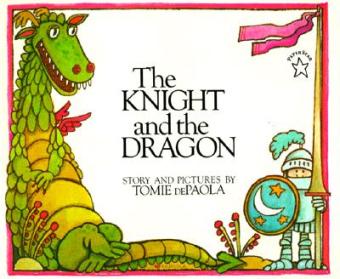
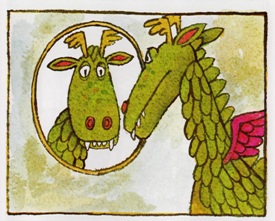
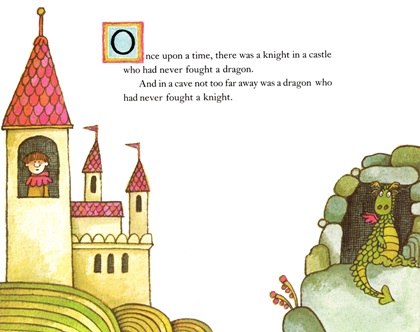
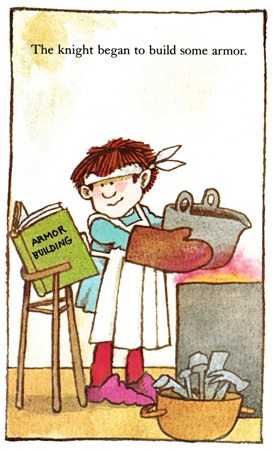
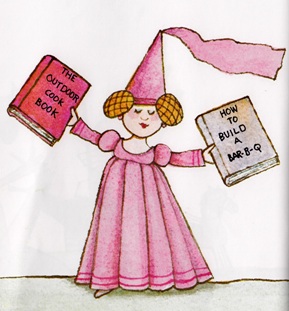
{ 1 comment… read it below or add one }
I was browsing through the net in search for a good book to buy as a loot for my son’s 3rd birthday party. As my son’s party theme would be ‘knights and princesses’, I thought of giving the kids each a book about knights. I found this particular book. As I further checked on the details of this one, I found your blog. I didn’t know about this site before, but I’m so glad I found. I love how you presented the review. I will definitely visit this site from time to time.
{ 1 trackback }